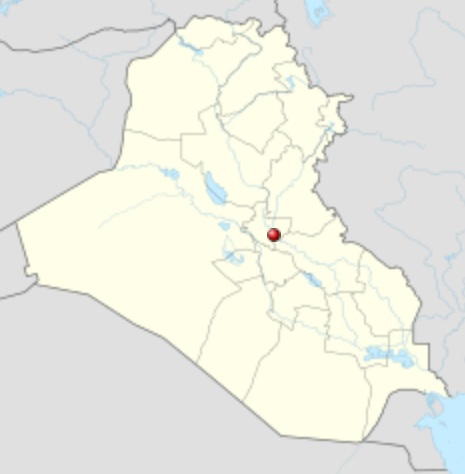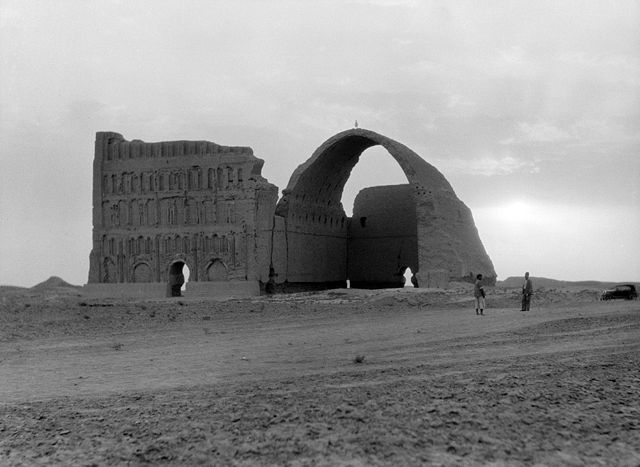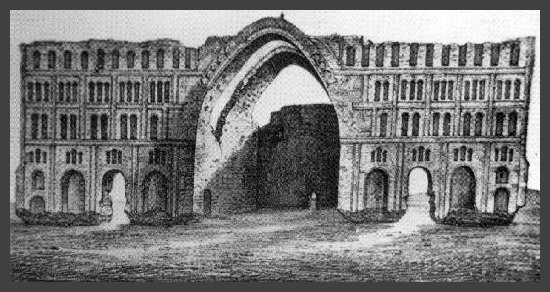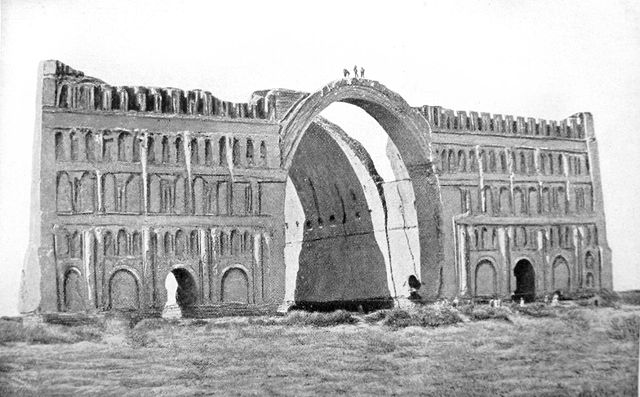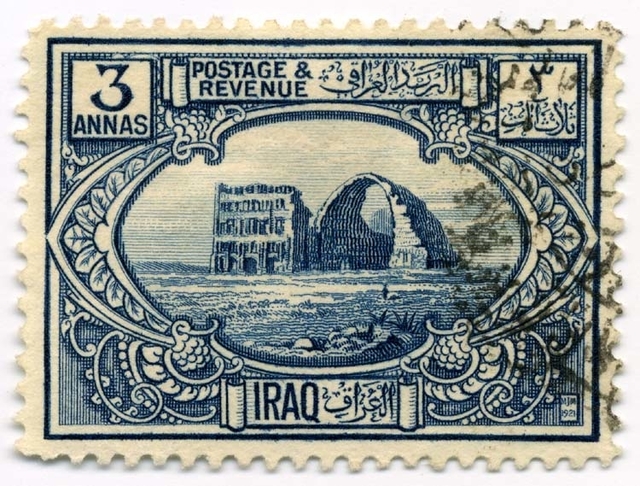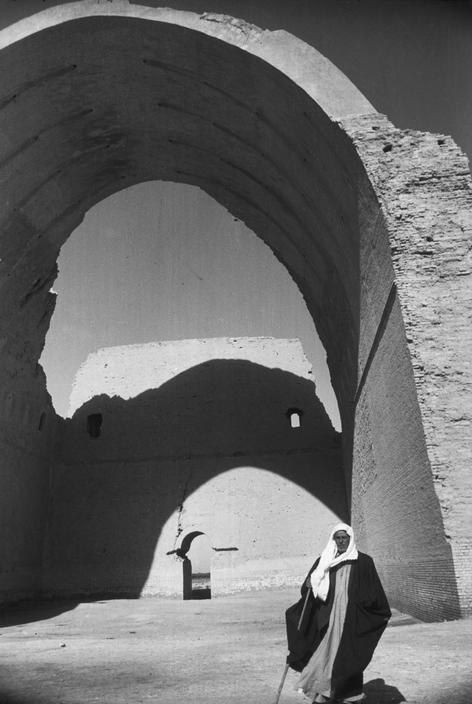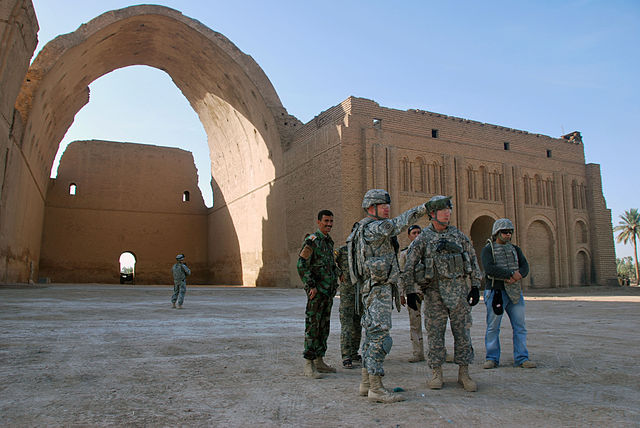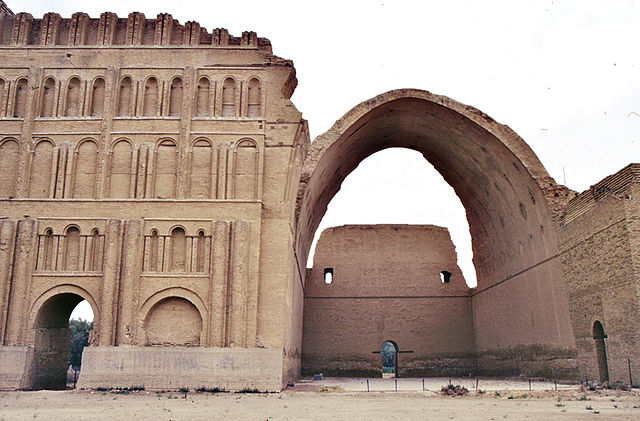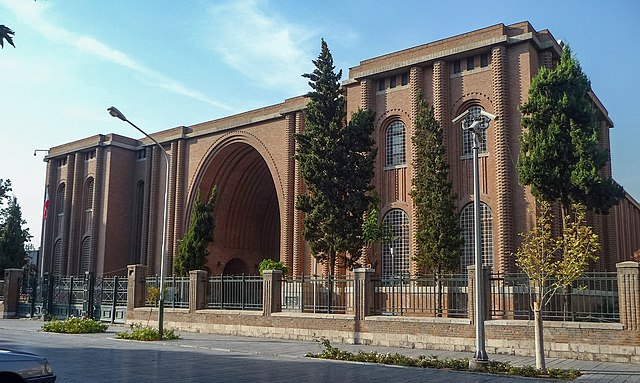
| TELL KASRA
Tell Kasra location in Ctesiphon, modern Iraq
Ruins of Ctesiphon, photographed in 1932 (from the United States Library of Congress) Location : Asbanbar quarter of Ctesiphon, Al-Mada'in, modern Iraq
Coordinates : 33°5'37 N 44°34'51 E
Height : 37 m (121 feet)
Built : ca. 3rd-6th century AD
Architectural style(s) : Iranian architecture
Taq Kasra (Arabic: romanized: taq kisra, also transcribed as Taq-i Kisra or Taq-e Kesra or Ayvan-e Kesra (Persian: romanized: 'iwan-i-husraw, meaning Iwan of Chosroes) are the remains of a Sasanian-era Persian monument, dated to c. the 3rd to 6th-century, which is sometimes called the Arch of Ctesiphon. It is located near the modern town of Salman Pak, Iraq. It is the only visible remaining structure of the ancient city of Ctesiphon. The archway is considered a landmark in the history of architecture, and is the largest single-span vault of unreinforced brickwork in the world.
History
:
The arch was part of the imperial palace complex. The throne room—presumably under or behind the arch—was more than 30 m (110 ft) high and covered an area 24 m (80 ft) wide by 48 m (160 ft) long. The top of the arch is about 1 meter thick while the walls at the base are up to 7 meters thick. It is the largest vault ever constructed in the world. The catenary arch was built without centring. In order to make this possible a number of techniques were used. The bricks were laid about 18 degrees from the vertical which allowed them to be partially supported by the rear wall during construction. The quick drying cement used as mortar allowed the fresh bricks to be quickly supported by those that were previously laid.
The Taq Kasra is now all that remains above ground of a city that was, for seven centuries—from the 2nd century BC to the 7th century AD—the main capital of the successor dynasties of the Persian empire: Parthians and Sassanids. The structure left today was the main portico of the audience hall of the Sassanids who maintained the same site chosen by the Parthians and for the same reason, namely proximity to the Roman Empire, whose expansionist aims could be better contained at the point of contact. [citation needed]
The structure was captured by the Arabs during the conquest of Persia in AD 637. They then used it as a mosque for a while until the area was gradually abandoned. In the early 10th century, the Abbasid caliph al-Muktafi dug up the ruins of the palace to reuse its bricks in the construction of the Taj Palace in Baghdad.
The monument is also the subject of a poem by Khaqani, who visited the ruins in the 12th century.
Modern
era :
In 1888, a serious flood demolished the greater part of the edifice.
In 1940, Roald Dahl, then undergoing pilot training at RAF Habbaniya near Baghdad took an award-winning photograph using a Zeiss camera of the Arch of Ctesiphon in Iraq which was subsequently auctioned by the Dahl family to raise funds for the Roald Dahl Museum and Story Centre. The photo made £6,000. In his autobiography Boy he writes :
You
may not believe it, but when I was eighteen I used to win prizes
and medals from the Royal Photographic Society in London, and from
other places like the Photographic Society of Holland. I even got
a lovely big bronze medal from the Egyptian Photographic Society
in Cairo, and I still have the photograph that won it. It is a picture
of one of the so-called Seven Wonders of the World, the Arch of
Ctesiphon in Iraq. This is the largest unsupported arch on earth
and I took the photograph while I was training out there for the
RAF in 1940. I was flying over the desert solo in an old Hawker
Hart biplane and I had my camera round my neck. When I spotted the
huge arch standing alone in a sea of sand, I dropped one wing and
hung in my straps and let go of the stick while I took aim and clicked
the shutter. It came out fine.
On March 7, 2019, a partial collapse further damaged the Taq Kasra, just two years after its latest restoration was completed.
In January 2021, Iranian Minister of Cultural Heritage Ali Asghar Mounesan mentioned that a credit of about $600,000 would be required for the restoration of Taq Kasra.
Documentary
film :
Gallery : Taq Kasra Gallery
1824 drawing by Captain Hart
Photo from 1864
1923 Iraqi postage stamp, designed by Marjorie Maynard, featuring the arch
Photo from 1932
Photo from 1950
Photo from 2009: Iraqi officials and American military officers discuss plans to renovate the existing structures
Photo from 2016
The National Museum of Iran, the architecture of which is adopted from that of Taq-i Kasra
Source :
https://en.wikipedia.org/ |
